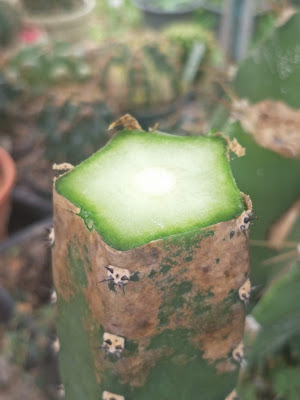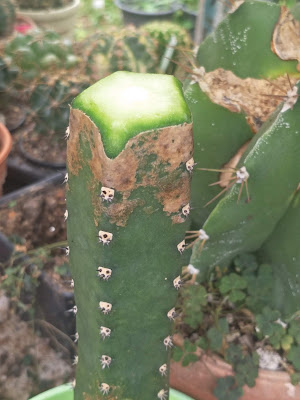How To Graft Ariocarpus On Harrisia jusbertii Root Stock
This applies to medium to large sized scion graft. Harrisia jusbertii serve as a great permanent root stock in most countries, It wasn't the fastest but might last longest compared to others.
Step 1
To begin with, get a decent root stock; make sure they are actively growing and plump. Never used dehydrated root stock which look flaccid and soft to the touch.
This Harrisia got a bit scald-looking scar from over application of dish soap lol. But it is doing fine, very solid and actively growing.
Now, cut the top part of your root stock, it can be the top 2-4 inch up to the mid, as long as the core i.e. middle ring is still soft. Best bet is to cut top 1 inch first and try to match it with scion middle ring, if your scion's ring bigger then cut another inch until they match.
Harrisia is a great root stocks due to their thickness and ring size. The thickness give us a good guarantee of grafting success as there is more contact between scion and root stock. Plus, it always put out a lot of sticky sap which means it is very unlikely to fail from dryness unless they does not place correctly or zero pressure applied.
Step 2
Cut your scion and make sure it is a level cut, skewed or concave cut on the scion may fail the graft, mostly due to shrinkage. I use Ariocarpus Godzilla variegated for this graft, around 4 cm big. The original plant is grafted onto a Myrtillocactus root stock but its been 6 months and no root is coming from the Myrtillocactus. Thus, this can be considered as my last measures to save the Ariocarpus.
For both scion and root stock cut, make sure you do it with sterile and very sharp knife.
Make sure the ring is similar in size to get better connection between scion and root stock.
For both scion and root stock cut, make sure you do it with sterile and very sharp knife.
Step 3
Match their cambium ring, as long as they touch each other; the graft will work well. Makesure the stay moist, never leave them too long or they will dry up and shrink or sunken.
Step 4
Providing pressure and preventing the scion from moving are two main concern in grafting. Without pressure holding the scion, it will detach or partially detach; which may lead to scion death or may require re-grafting.
I use plastic food wrap and rubber to hold them together, some times just rubber. Cereus root stock has thick long thorns that can be use to hold the plastic, but additional rubber use can reduce the risk of losing pressure.
Apply rubber to hold your plastic cover in place, I use one rubber but fold it once so it stretch tighter.
Do your final adjustment if needed and left them under shade for a while. the advantage of using plastic wrap is they retain moisture from cut so they don't shrink quickly. Sometimes I forgot about my grafts, the scion just pop out of the plastic and continue growing; just make sure it is soft plastic wrap though.
I use plastic food wrap and rubber to hold them together, some times just rubber. Cereus root stock has thick long thorns that can be use to hold the plastic, but additional rubber use can reduce the risk of losing pressure.
Pull the plastic and make sure it is fittingly tight, not loose but also no too tight. you can test the scion after attaching plastic cover, if it shift to any direction; adjust the holding pressure.










Interesting... May I know the update please.
ReplyDeleteIt died lol. Was a struggling Ariocarpus to begin with. The rootstock pups though.
ReplyDeleteI find that it is fun to graft Harrisia onto other stock such as Hylocereus.
But for Harrisia graft, you need a very plump and healthy scion to get the union work well.
It produce lots of sap and very sticky, bit I believe that Myrtillocactus is more promising to succeed.
Maybe I'm not very used to it yet.
Will give it more try, lota of stocks are waiting.
Plastic cover without any hole to air movement increase fungal activity and rot. Thus plastic is the killer of it
ReplyDelete